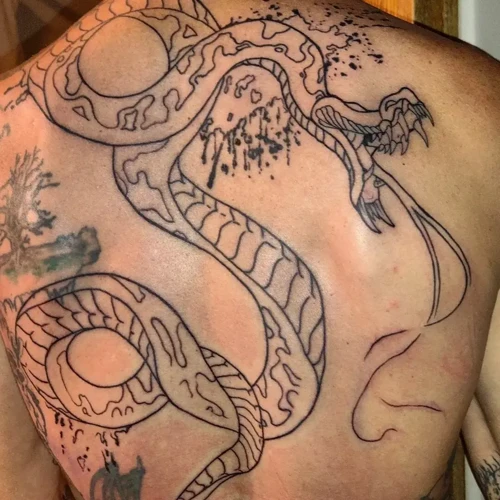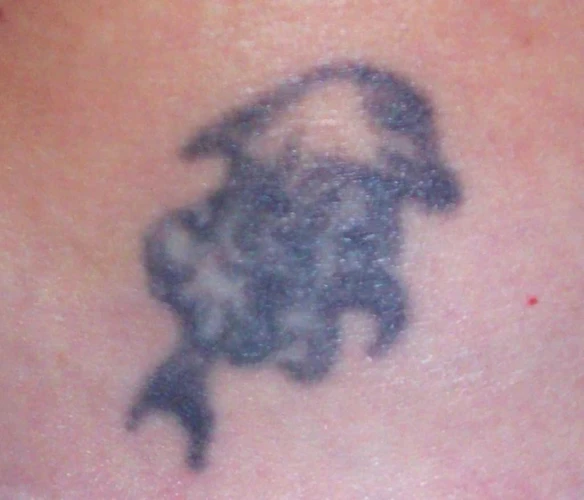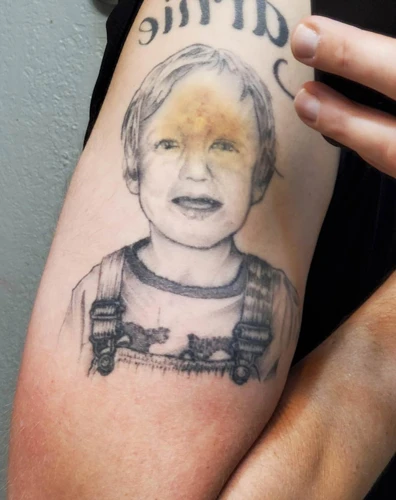If you have recently got a tattoo, you may be wondering how long does tattoo flu last and what can you do to manage it. Tattoo flu is a term used to describe the body’s natural reaction to the process of getting a tattoo. This includes swelling, redness, and itchiness, which can all linger for a few days. Knowing how long tattoo flu typically lasts and how to care for your new tattoo can help you get through the process with minimal discomfort.
Contents
What is Tattoo Flu?

Tattoo flu is a reaction to the skin healing process after getting a tattoo. It is a normal condition which occurs when the body is trying to heal from the trauma caused by the needles used in the tattooing process. The condition is also known as tattoo fever, tattooing aftercare or tattoo healing process.
- Symptoms of Tattoo Flu – Swelling, redness, itching, burning, oozing, aching or tenderness at or around the site of the tattoo
- Timeline – Tattoo flu generally lasts for 7-10 days, depending on the size and complexity of the tattoo.
- Prevention – To prevent tattoo flu, it is important to take precautions to ensure that the tattoo is done in a clean environment and that the artist is using sterile equipment. Additionally, it is important to follow the aftercare instructions provided by the artist.
- Management – To manage tattoo flu, it is important to keep the area clean and dry. Applying a cold compress to the area can help to reduce swelling and itching. It is also important to avoid picking or scratching the area and to avoid exposing the area to the sun. Additionally, applying a moisturizer can help to soothe the skin and aid in the healing process.
Tattoo flu is a normal part of the healing process and should not be a cause for concern. If you experience severe symptoms or if the tattoo does not seem to be healing properly, it is important to seek medical attention.
Signs and Symptoms of Tattoo Flu

- Pain – the area of the tattoo may feel tender or sore, and you may experience a burning sensation.
- Itching – the area may be itchy, especially if the skin is healing too quickly or if the tattoo is in a difficult-to-reach area.
- Redness – the area may become red and inflamed, often accompanied by swelling.
- Fever – you may experience a fever or mild fever-like symptoms.
- Fatigue – you may feel tired and weak, or experience chills or nausea.
- Blistering – the area may become covered in blisters or pustules.
Tattoo flu is a common side effect of getting a new tattoo, and the symptoms can last for up to two weeks. If you are experiencing any of the above symptoms, it is important to take steps to manage the discomfort and help your body recover faster. To get over tattoo flu quickly, it is important to keep the area clean and moisturized, and to avoid picking at the scabs or scratching the tattoo.
How Long Does Tattoo Flu Last?

Tattoo flu is a term used to describe the discomfort, pain and soreness experienced after getting a tattoo. It usually occurs a few days after getting a tattoo and can last for up to a few weeks depending on a few factors.
- It is normal to experience soreness, redness, swelling and itching around the area of the tattoo.
- The severity and duration of tattoo flu can depend on the size and complexity of the tattoo, skin type, amount of ink used, and the artist’s technique.
- Tattoo flu usually lasts anywhere from one to three weeks.
- Some people may experience a longer period of discomfort and soreness that can last for up to a month.
- It is important to take care of a new tattoo, as it is still healing and the area is prone to infection.
How to avoid tattoo flu?
- Make sure to follow the aftercare instructions given by your tattoo artist.
- Apply a thin layer of an antibiotic ointment to the area.
- Keep the area clean and dry with a mild soap or tattoo aftercare product.
- Avoid direct sunlight and hot water to prevent irritation and infection.
- Avoid any activities that might cause the tattoo to rub or scratch against any clothing, furniture, or other objects.
- Drink plenty of water to promote healing and prevent infection.
- Eat a balanced diet to help with the healing process.
- Avoid smoking and excess alcohol consumption.
By taking proper care of your tattoo and following the instructions given by your tattoo artist, you can help to reduce the severity and duration of tattoo flu. It is important to be patient and allow your tattoo to heal in its own time.
Causes of Tattoo Flu

Tattoo Flu, also known as Tattoo Sickness, is a mild infection that can occur after getting a tattoo. It is caused by an immune system reaction to the tattoo ink and needles used during the tattooing process.
Infection – Tattoo Flu is caused by an infection of the skin, which can be caused by a number of different bacteria. The most common type of bacteria is Staphylococcus aureus, which is found on the surface of the skin. Other types of bacteria can also cause infection, such as Streptococcus and Escherichia coli.
Allergies – Allergic reactions to the ink used in tattoos can also cause Tattoo Flu. Allergies can be caused by a variety of different ingredients in the ink, such as dyes, preservatives, and fragrances.
Reactions to Needles – Another cause of Tattoo Flu is a reaction to the needles used during the tattooing process. These needles can cause an inflammatory reaction, which can cause swelling and redness of the skin.
Immune System Response – The body’s immune system can also cause Tattoo Flu as it reacts to the foreign substances in the ink and needles. The body’s immune system will try to fight off the foreign substances, which can cause inflammation and irritation of the skin.
How Long Does Tattoo Flu Last? Tattoo Flu typically lasts for a few days or weeks, depending on the severity of the infection. It can be managed with proper hygiene and treatment, such as antibiotics or topical ointments.
How to Avoid Tattoo Flu
Tattoo flu is a condition caused by an immune response to the tattoo ink, making it difficult to get through the healing process. The best way to avoid it is to take preventive measures before getting the tattoo. Here are some tips:
Choose a Clean Tattoo Parlor: Get your tattoo done in a reputable and licensed tattoo shop with proper sanitation protocols. Make sure the artist has a valid license, uses sterile equipment, and wears gloves and a face mask.
Get Tested: Before getting a tattoo, get tested for any allergies to the ink and make sure you don’t have an infection.
Use Quality Ink: Make sure the tattoo artist uses quality, non-toxic, and sterile inks.
Follow Aftercare Instructions: Follow the artist’s instructions for aftercare, including cleaning and moisturizing the skin and avoiding excessive sun exposure.
Ask Questions: Ask your artist any questions you have about the tattoo process and aftercare.
By taking these steps, you can reduce your risk of experiencing tattoo flu and make sure your tattoo heals properly. If you start feeling sick after getting a tattoo, it is important to seek medical attention to determine why you are feeling unwell and what the best course of action is.
How to Get Over Tattoo Flu

Getting over tattoo flu can be tricky, but it is possible. The most important thing to remember is that it will pass in time. It is important to take proper care of your tattoo to help speed up the healing process and minimize discomfort. Here are some tips to help you get over tattoo flu:
Rest: Get plenty of rest and take it easy. Your body needs time to heal, so allow yourself time to rest and relax.
Keep It Clean: Clean your tattoo with a gentle soap and warm water. Make sure to pat it dry with a clean cloth.
Apply Ointment: Apply a thin layer of ointment to your tattoo to keep it moist and help prevent infection.
Avoid Sun: Avoid direct sunlight on your tattoo as it can cause fading, blistering, and scarring.
Wear Loose Clothing: Wear loose clothing to help the tattoo heal and prevent irritation.
Take Pain Medication: Take over-the-counter pain medication such as ibuprofen or acetaminophen to help manage any pain or discomfort.
Seek Medical Attention: If you experience any signs of infection or have severe pain, seek medical attention immediately.
By following these tips, you can help your tattoo heal faster and get over tattoo flu in no time. Although it may seem like it will last forever, tattoo flu typically only lasts for about one to two weeks. So, hang in there and take good care of your tattoo!
What to do When You Feel Sick After a Tattoo

- Drink plenty of fluids. It is important to stay hydrated when you feel sick. Drink plenty of water, ginger ale, and electrolyte-rich drinks such as sports drinks or coconut water. Avoid sugary drinks or caffeinated beverages.
- Get plenty of rest. Taking a nap or getting extra sleep can help your body to recover more quickly from a tattoo. It is important to listen to your body and rest when you feel you need to.
- Eat light meals. Eating light meals that are easy to digest such as soups, salads, and smoothies can help to replenish your energy and give your body the nourishment it needs to heal.
- Take over-the-counter medications. Pain relievers, anti-nausea medicines, and anti-inflammatory medications can help to alleviate some of the symptoms of tattoo flu. It is important to talk to your doctor before taking any medication.
- Apply a cold compress. Applying a cold compress or ice pack to the area of your tattoo can help to reduce swelling, pain, and itching. Make sure to use a clean cloth or towel and do not apply the ice directly to your skin.
- Wear loose-fitting clothing. Wearing loose-fitting clothing can help to reduce irritation and discomfort. Avoid wearing tight clothing that may rub against your tattoo.
- Use lotion. Applying a gentle, unscented lotion to your tattoo can help to keep your skin moisturized and reduce itching and discomfort. Make sure to use a lotion that is specifically designed for tattoos.
If you are feeling sick after a tattoo, it could be due to a condition known as ‘tattoo flu’. This is a common side effect of getting a tattoo and usually occurs within the first few days after getting inked. Symptoms of tattoo flu include nausea, headaches, fever, chills, and body aches. Why do I feel cold after getting a tattoo? Chills and feeling cold are also common symptoms of tattoo flu.
Treatments for Tattoo Flu
- Rest and Sleep: Getting plenty of rest and sleep can help the body recover from the tattoo procedure and reduce symptoms of tattoo flu.
- Hydration: Drinking plenty of water helps to keep the body hydrated, which may reduce symptoms of tattoo flu.
- Heat: Applying a warm compress to the area of the tattoo may help reduce any discomfort.
- Ice: Applying a cold compress to the area of the tattoo may also help reduce any swelling or inflammation.
- Pain relief: Over-the-counter pain medications, such as ibuprofen or acetaminophen, may help to reduce any pain or discomfort.
- Antibiotics: If the tattoo is infected, your doctor may prescribe antibiotics to help control the infection.
Frequently Asked Questions
What is Tattoo Flu?
Tattoo flu is a condition that many people experience after getting a tattoo. It is characterized by a feeling of flu-like symptoms, such as fever, chills, body aches, nausea, and fatigue.
- Fever
- Chills
- Body aches
- Nausea
- Fatigue
It is a common reaction of the body’s immune system to the trauma of getting a tattoo. While it can be uncomfortable and unpleasant, it is usually not serious. Tattoo flu typically resolves itself within a few days.
What are the Common Symptoms of Tattoo Flu?
Tattoo flu is a condition that occurs after getting a new tattoo. It is usually characterized by flu-like symptoms such as fever, chills, body aches, fatigue, and headache. Other symptoms may include nausea, vomiting, and/or diarrhea. Additionally, the area around the tattoo may become red, swollen, and tender. It is important to note that these symptoms are usually mild and should not last for more than a few days.
How can I prevent tattoo flu?
Practise Good Hygiene – Always wash your hands before touching a new or fresh tattoo, and ensure that the area is kept clean. Change the bandage regularly, and wash the tattoo with a mild soap and lukewarm water. Avoid swimming, hot tubs and soaking in water while the tattoo is healing.
Keep the Tattoo Moist – Applying a thin layer of a fragrance-free lotion or moisturizer can help to keep the tattoo from drying out. Do not use Vaseline or Neosporin as these can clog pores and trap bacteria.
Avoid Excessive Sun Exposure – Sunlight can cause the tattoo to fade and is especially damaging to tattoos that are still healing. Cover the tattoo with clothing or sunscreen with an SPF of 30 or higher.
Is it Safe to Get a Tattoo When I Have Tattoo Flu?
Tattoo flu is an infection caused by bacteria or fungi that can occur during the healing process of a new tattoo. While it is not dangerous, it can cause symptoms that can make getting a new tattoo uncomfortable, and could even lead to further complications. It is therefore important to wait for the infection to clear before getting a new tattoo. If the infection is still present, it is best to consult a medical professional for advice and treatment before getting a new tattoo.
What are the Best Ways to Manage Tattoo Flu?
- Stay Hydrated: Drinking plenty of water helps to flush out the body’s toxins, including the ink particles that remain in the skin after a tattoo.
- Take Medication: Anti-inflammatory medications such as ibuprofen can help to reduce swelling and pain associated with tattoo flu.
- Keep the Area Clean: Keeping the area clean with a gentle soap or antiseptic solution helps to prevent infection and promote healing.
- Avoid Sun Exposure: Sun exposure can irritate the sensitive skin around the tattoo, which can worsen the symptoms of tattoo flu.
- Avoid Exercise: Exercise can increase the amount of blood flow to the area, exacerbating the symptoms of tattoo flu.
- Avoid Hot Showers: Hot showers can irritate the skin and make the symptoms of tattoo flu worse.
Conclusion
Tattoo flu is a common medical condition that can be uncomfortable and inconvenient to manage. The duration of tattoo flu varies depending on the individual and the severity of their symptoms. Generally, it can last from a few days to a few weeks. To manage the discomfort of tattoo flu, it is important to rest, keep the tattoo clean, and use topical medications as prescribed. If symptoms become severe or last for an extended period of time, it is important to seek medical attention.